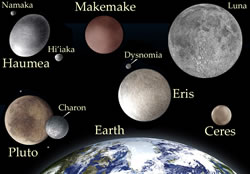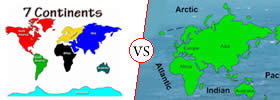Difference between Dwarf Planet and Asteroids
Key difference: A dwarf planet is “a celestial body in direct orbit of the Sun that is massive enough for its shape to be controlled by gravitation, but that unlike a planet has not cleared its orbital region of other objects.” An asteroid, on the other hand, is a large chunk of rock that orbits around the sun. Asteroids are also known as planetoids or minor planets.
include("ad4th.php"); ?>
 The International Astronomical Union (IAU) defines a dwarf planet as “a celestial body in direct orbit of the Sun that is massive enough for its shape to be controlled by gravitation, but that unlike a planet has not cleared its orbital region of other objects.” The term dwarf planet was adopted by the IAU in 2006 as part of a three-way categorization of bodies orbiting the Sun.
The International Astronomical Union (IAU) defines a dwarf planet as “a celestial body in direct orbit of the Sun that is massive enough for its shape to be controlled by gravitation, but that unlike a planet has not cleared its orbital region of other objects.” The term dwarf planet was adopted by the IAU in 2006 as part of a three-way categorization of bodies orbiting the Sun.
Also see: Difference between dwarf planet and moons
An asteroid, on the other hand, is a large chunk of rock that orbits around the sun. Hence, asteroids are effectively part of our Solar system. Asteroids are also known as planetoids or minor planets. The term minor planet is actually preferred in some scientific communities. However, according to the IAU, an asteroid is categorized as a small Solar System body, unless it meets the requirements to be a dwarf planet.
There are effectively millions of asteroids. Most asteroids in our solar system are part of the asteroid belt located between the orbits of Mars and Jupiter. The asteroid belt consists of tens of thousands of asteroids. They are generally rocks that have a high metallic content but no atmosphere. The size of an asteroid can range anywhere between a few meters wide and hundreds of km wide. They are smaller than planets but like planets, some even have their own moons.
include("ad3rd.php"); ?>
As per the IAU's final Resolution 5A, planets and other bodies, except satellites, in our Solar System can be defined into three distinct categories:
- A planet is a celestial body that (a) is in orbit around the Sun, (b) has sufficient mass for its self-gravity to overcome rigid body forces so that it assumes a hydrostatic equilibrium (nearly round) shape, and (c) has cleared the neighborhood around its orbit.
- A "dwarf planet" is a celestial body that (a) is in orbit around the Sun, (b) has sufficient mass for its self-gravity to overcome rigid body forces so that it assumes a hydrostatic equilibrium (nearly round) shape, (c) has not cleared the neighborhood around its orbit, and (d) is not a satellite.
- All other objects, except satellites, orbiting the Sun shall be referred to collectively as "Small Solar System Bodies."
The need for this three-way categorization arose as more and more trans-Neptunian objects were discovered. These trans-Neptunian objects, i.e. objects located further than Neptune, were equal to or even bigger than the size of Pluto. Furthermore, it was discovered that Pluto was actually roughly one-twentieth the mass of Mercury, or one-fifth as massive as Earth's Moon. In addition, it was discovered that Pluto has some unusual characteristics such as large orbital eccentricity and a high orbital inclination. Hence, it was completely different than the other planets.
Also see: Difference between asteroids and planets
 According to the previous categorization, all of the newly discovered trans-Neptunian objects would also be classified as planets, even though, like Pluto, they did not fit the traditional definition of a planet. So, the new three-way categorization model was adopted. Under this model, Pluto was demoted to a dwarf planet, while other solar objects that were too big to be classified as asteroids but did not meet the requirements for a planet were also classified under dwarf planets.
According to the previous categorization, all of the newly discovered trans-Neptunian objects would also be classified as planets, even though, like Pluto, they did not fit the traditional definition of a planet. So, the new three-way categorization model was adopted. Under this model, Pluto was demoted to a dwarf planet, while other solar objects that were too big to be classified as asteroids but did not meet the requirements for a planet were also classified under dwarf planets.
Currently, the IAU recognizes five dwarf planets in our Solar System: Ceres, Pluto, Haumea, Makemake, and Eris. However, only Ceres and Pluto have been observed in enough detail to demonstrate that they fit the definition. Hence, the other may or may not be reclassified as new information is available. It is estimated that there may be 200 dwarf planets in the Kuiper belt of the outer Solar System, and up to 10,000 in the region beyond.
Hence, the main difference between a dwarf planet and an asteroid is that a dwarf planet is an asteroid that is big enough to have a gravitational force that has allowed the asteroid to compound itself to a spherical shape. If the gravitational force was strong enough to allow the asteroid to clear its orbit, in addition to shape itself, then the asteroid would be termed as a planet.
Image Courtesy: factfile.org, todayifoundout.com









Add new comment